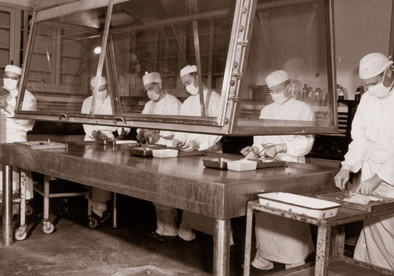- Homepage >
- Organization >
- History
History
The land presently occupied by DPG has played an important role in the development of transcontinental transportation in the United States. DPG is located in the southern end of the Great Salt Lake Desert which extends from near the Idaho state line, south to the Fish Springs Mountain Range, and from the Great Salt Lake and Wasatch Mountains, west to the Nevada state line. The desert narrows towards its southern extreme and is most narrow at the stretch between Granite Peak and Black Point in the southwestern corner of DPG.
In the early days of transcontinental travel, the southern route across the desert offered several advantages to those who selected it. This route reduced the overall desert travel time and distance between water sources along the travel route, eliminated the steep grade of Beckwith Pass in the northern Wasatch Mountains, and avoided difficult travel across the mud flats west of the Great Salt Lake.
From the early 1800s, a steady stream of people with varying purposes (exploration, freight and mail transport, mining, homesteading, and later, tourism) used the route across the southern end of the Great Salt Desert. This stream increased in the mid-1800s with the discovery of gold in California. Most of the activity throughout the 19th century occurred just outside DPG and did not leave structural traces (an exception is an historic bridge remnant of the Lincoln Highway Goodyear Cutoff, located on the east side of DPG's Ditto Area). A brief summary of the early developments in transportation and communications is provided here to indicate the broad historical developments and land uses that had an impact in the general vicinity of DPG.

The attack on Pearl Harbor in 1941 jarred the United States and its military forces. The Nation suddenly realized a need for increased military capability in many areas, which included expanded knowledge in chemical and biological warfare.
On February 6, 1942, President Franklin D. Roosevelt withdrew an initial 126,720 acres of Utah land from the public domain for use by the War Department. Six days later Dugway Proving Ground was established, with official activation on March 1. Testing was under way by that summer.
Dugway Proving Ground was authorized to fill the need for testing weapons and defenses against chemical and biological weapons of mass destruction. Important projects during this early period included testing incendiary bombs, chemical weapons, and modified agents as spray disseminated from aircraft. Testers also did pioneer work on mortars.
Over the years, the proving ground underwent various name changes and periods of deactivation and reactivation. In 1943, the Army established biological warfare and testing facilities at Dugway. The size of the installation was increased in 1945, when part of the Wendover Bombing Range was transferred to proving ground operations.
After the war, the proving ground combined with the Desert Chemical Depot to form a single Command called the Dugway Desert Command, later renamed the Western Chemical Center. The installation was then placed on a standby.
In 1950, the center resumed active status, and acquired an additional 279,000 acres of land for exclusive use. Work continued through the 1950s, with new responsibilities being added as defense weaponry evolved. In 1954, Dugway Proving Ground was confirmed as a permanent installation.
In 1968, the Fort Douglas-based Deseret Test Center and Dugway Proving Ground combined and became known as the Deseret Test Center. This alliance lasted until 1973, when the present Dugway Proving Ground became part of U.S. Army Test & Evaluation Command (TECOM) headquartered at Aberdeen Proving Ground, Maryland. In 1999, TECOM became the Developmental Test Command (DTC), aligned under the Army Test & Evaluation Command (ATEC) in Alexandria, Virginia.
The present day Dugway Proving Ground now covers 798,214 acres. In addition to chemical and biological defensive testing, environmental characterization, and remediation technology testing Dugway is the Defense Departmentís leader in testing battlefield smokes and obscurants. Testing now includes further determining the reliability and survivability of all types of military equipment in a chemical or biological environment.
For a more detailed look at the history of Dugway Proving Ground, see the links below.
HISTORY  1800-1942
1800-1942  1942-1945
1942-1945  1945-1950
1945-1950  1950-1963
1950-1963  1963-1972
1963-1972  1972-1989
1972-1989
